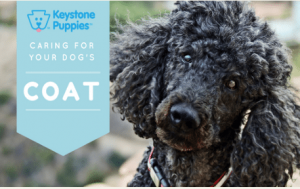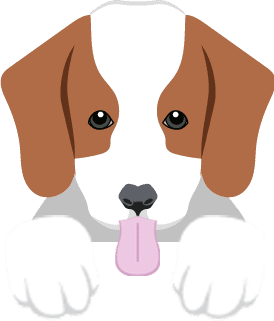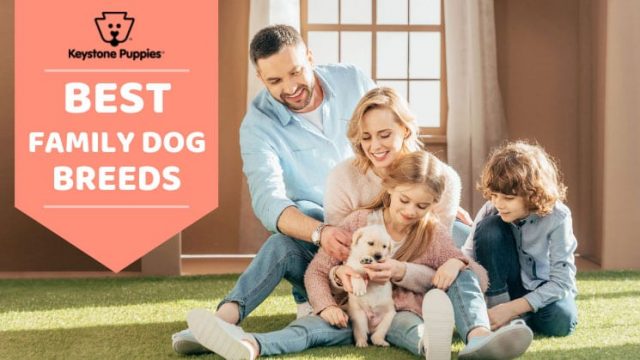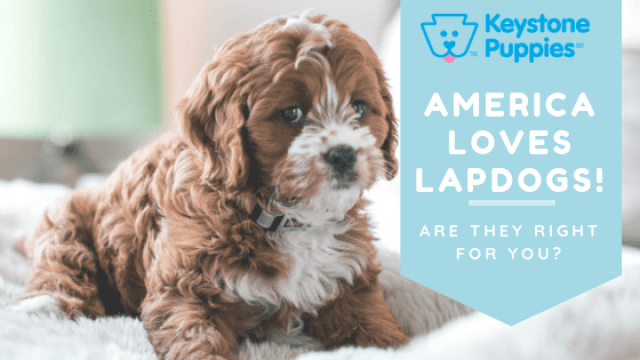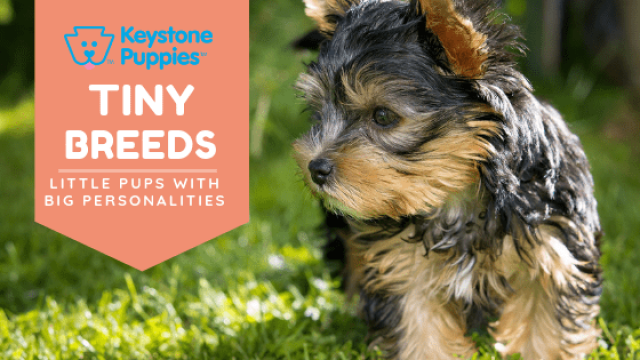5 Things to Remember When Choosing a Puppy
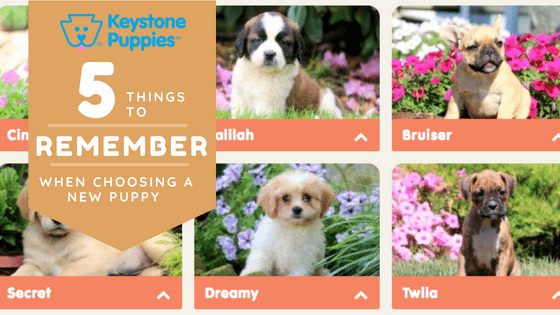
Choosing a puppy can be fun and exciting. For people who are still deciding on a breed or type of dog, it’s easy to get lost in the wide variety of choices. Large, handsome, hunting dogs like Golden Retrievers or Irish Setters appeal to some people, while other choose a charming lapdog such as a Shih Tzu or Pekingese. The scrappy, street-wise appeal of Boxers and Bulldogs wins many hearts, while others fall for the friendly faces of Collies or Corgis.
While looks are important, there are even more critical elements to consider when choosing a puppy. These factors will determine each pup’s long-term suitability with your home, your friends and family, and your lifestyle.
Factor One: How Much Exercise Will This Pup Need?
Meeting a puppy’s exercise needs is one of the most effective ways of avoiding undesirable behaviors. Dog’s exercise requirements vary widely. Shih Tzus are content with short walks and occasional romps, while Border Collies were bred as herding dogs and need time every day for running and vigorous play. Dogs that are deprived of adequate exercise can chew household items, dig indoors, chase and nips people, or even behave aggressively.
That’s why it’s so important to research the breed of your dog or the breeds that contributed to your pup and make sure you have room in your home and yard for the appropriate activity levels. If you want to bring an active puppy into your life, make sure you have time to take him on long daily walks, play fetch, or to visit a dog run.
If you’re unable to spend lots of time exercising your dog, then it’s wise to choose a breed that requires less activity. For example, smaller dogs usually need less exercise than larger breeds. Terriers typically need more exercise than lap dogs.
Dogs that are considered lap dogs, like the Bichon Frise, usually need less exercise. To learn more about lapdogs, check out our blog, Loveable Lapdogs.
There are several other breeds that are considered low-exercise dogs. They include Basset Hounds, English Bulldogs, and Chow Chows. For a more complete list of low-energy dogs, check out this list from Good Housekeeping.
Factor Two: What is This Puppy’s Temperament?
Many breeds of dogs have been bred to display a particular temperament. For example, as discussed in our blog, Hunters and Hounds, hunting dogs were bred to be useful in group outings with many people and lots of dogs. That explains why they were bred for selected traits such as welcoming new people, getting along well with other dogs, and being loyal to their master. As a result, most hunting breeds display some level of these qualities. Golden Retrievers and Labrador Retrievers are two of the most popular breeds in America because of these people-friendly traits.
Other pups, like Chow Chows, Shih Tzus, and Shiba Inus were bred to be watchdogs. These pups are alert, intelligent, and territorial, which combine to make them excellent guardians of people and property.
Still, others were bred to be snuggly companion dogs. If you want a puppy that is affectionate, likes to lie on your lap, and adores a good cuddle, you may want to consider a breed like a Maltese, a Bichon Frise, or a Chihuahua.
If you’re considering a designer breed (a breed that is an intentional mix of two established breeds) study the temperaments of both parents. Many designer breeds have established personality characteristics. For example, Cockapoos, a mix between a Cocker Spaniel and a Poodle, are identified as intelligent, active, and quick to learn. Schnoodles, a mix between a Mini Schnauzer and a Mini Poodle, are lively, intelligent, and affectionate. If you want to find out more about designer breeds, check out our blog, Oodles of Doodles and ‘Poos, or research your designer breed’s temperament by clicking here.
Remember that breed temperaments are based on averages, and that each puppy is an individual. Some dog’s temperaments may vary from the breed norm.
Factor Three: What are the Companionship Needs of This Puppy?
What are your dog’s social and emotional needs? Lonely dogs will bay, bark, howl, and destroy property. On the other end of the spectrum, dogs that are overwhelmed by new people or groups may growl, nip, bite, or act out in other ways. It’s important to know how your breed will interact with you, your visitors, and other pets.
Once again, different breeds, and breed types, were bred to bring forward different emotional and social tendencies. Lap dogs such as Pomeranians and Pugs are usually very attached to owners and get lonely easily. Working dogs like Bernese Mountain Dogs, Cane Corsos, and Newfoundlands were often bred to be more independent. These breeds were often farm dogs that slept in barns. They’re usually more comfortable with owners being gone for longer periods of time.
Research your breed, or your mix of breeds, and make sure you choose a dog that will be comfortable with your lifestyle and your absences. If you must travel regularly, choose a dog that is comfortable spending time away from his owner, or is very social with other dogs and doesn’t mind boarding in kennels. Conversely, if you have a household that is often filled with family or guests, don’t choose a reserved dog that is wary of strangers.
Factor Four: What Kind of Grooming Will This Dog Require?
Some dog owners love grooming their pup. They enjoy combing out the coats, bathing, and even styling their dog’s fur or hair. Other dog owners prefer a “wash and wear” approach, with very little brushing or grooming involved.
When factoring the time you will need to spend on grooming your puppy, hair length is key. Shorthaired dogs like Beagles and Dobermans need very little grooming and no trimming. Dogs with shaggy coats, like American Eskimo Dogs and dogs with wiry coats, like Airedales and West Highland Terriers, need special care with specific types of brushing to keep their coats healthy.
Other grooming considerations are teeth, ears, paws, and eye care. Some breeds require diligent maintenance of these areas. Other breeds require almost none.
Shedding is another concern for new dog owners. The assumption is that short-haired dogs won’t shed as much, but rarely true. Shedding has little to do with hair length. Most dogs shed to some degree, and short haired dogs can shed as much as long-haired pups. Conscientious grooming and coat care will dramatically reduce shedding on almost any type of dog.
Coat care, shedding issues, and care of eyes, ears, teeth, and paws should be carefully researched before choosing a puppy. Check out our blog on coat care to learn more about grooming requirements, and read WebMD’s advice on how to minimize shedding.
Factor Five: How Large Will This Pup Grow?
Little puppies are irresistible, but they will quickly grow into dogs. That’s why you need to understand exactly how large that dog will become, food needs, and adult energy levels.
When thinking about dog size, It’s important to remember that dog size has very little correlation to aggression or personality. Many large breeds are famously sweet and loving, while some tiny dogs are possessive and like to nip. Don’t assume that size and temperament have any correlation.
However, size does matter when it comes to fitting a dog into your home. Size-wise, it’s undeniably easier to find a place in your home for a small dog such as a Yorkshire Terrier. His bed and food bowls fit into almost any corner. However, creating sleeping and feeding areas for large breeds like Great Danes can take more planning.
If you have young children, you may want to look for medium-sized dogs. Small breeds can be easily injured by children who are not yet able to manage gentle handling. Conversely, it’s common for very large dogs to accidentally push babies and toddlers aside or hit them with a wagging tail.
And finally, there is a huge difference in the feeding needs and expense of large dogs vs. small dogs. For more information, check out our blogs on how to feed small dogs, and how to feed large dogs.
*****
Finding the right forever dog for your home can be fun and exciting, but looks can be deceiving. You may love the look of a dog, but quickly tire of its activity requirements, breed traits, sociability, or ability to interact with children, guests, or other pets. Make sure you research all aspects of your new puppy to make sure they’ll be a perfect fit for your household. To research over 200 breeds, click here. If you know which breed is right for you, start looking for your new puppy here.

